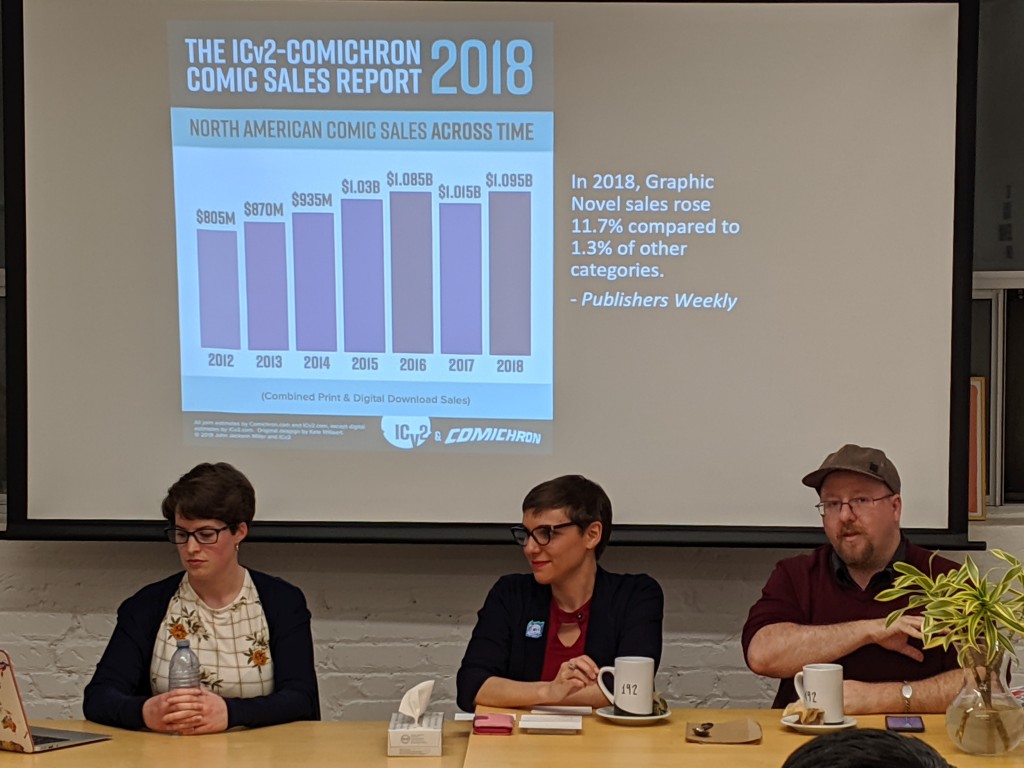by Catherine Dorton and Paul Ling

On Tuesday, October 22, Editors Toronto hosted a lively panel discussion with comics anthology editor Allison O’Toole, cartoonist Megan Kearney, and TO Comix Press founder Steven Andrews.
These three industry pros were full of ideas and inspiration for comic book creators, anthology curators, editors, and anyone else interested in breaking into the field. They introduced us to some trends, including the explosion of sales in comics, new publishing imprints dedicated to graphic novels, and self-publishing opportunities. They made sure we knew what counts as a comic (hint: it isn’t merch!) and what kinds of stories readers are hungry for (lesson #1: not capes). According to the trio, superhero comic sales are down, while emotionally complex, historical, and pop culture content is on the rise. Also, the growing landscape of new artists is wonderfully diverse, expanding the field for audiences of all ages, ethnicities, abilities, and orientations.
Next, the panellists outlined the roles an editor might play in all stages of the publishing process, from gathering the material to editing the story and art to creating publishing schedules and resolving disputes. (So editors of comics need to be flexible and comfortable in various roles!)
Finally, they explained how editors work with text and images, covering a gamut of details from the basics, such as choosing the appropriate fonts, to the complex, such as outlining page flows for proper reading sequence. They showed examples of “thumbnails” (small sketches) for the layout of an entire storyline followed by rough sketches with text included to work outpacing, perspective, movement, and emphasis. According to the panellists, once the roughs are approved, the artist sketches the finals in pencil, and these are then inked. Often, a separate colourist is brought on board. Things to consider at this last stage include palette, shading, and medium (e.g., digital vs. watercolour).
Allison, Megan, and Andrew clearly know how to “walk the talk” when it comes to the basics of visual literacy because the slideshow that accompanied their presentation was excellent. They kindly agreed to share it with us.
[Click here to automatically open the PDF of the presentation slides in a new browser window or tab.]
The evening concluded with a Q&A session with our panellists.
Since the night of this panel, Editors Toronto has become aware of a significant interest in this topic. If you are an Editors Canada member and would like to participate in an ongoing group dedicated to comics at the Toronto branch, let us know in the comments below or send an email to [email protected].
Resources
TO Comix Press (tocomix.com): Look under the Articles tab for information on curating anthologies, stylistic conventions (e.g., lettering, placement of balloons and captions, and punctuation), contracts, and more.
Blambot (blambot.com): Under the Resources tab, click on Comic Book Grammar and Tradition for an alphabetic list of aesthetic conventions unique to comics such as breath marks, double dashes, number style, and whispering.
Understanding Comics by Scott McCloud (William Morrow, 1995) is a comic book about comic books that deconstructs the language and visual communication of comics, showing how words and pictures combine to make magic.
Drawing The Inside Out: Making Comics From Your Life is a four-week workshop on the craft of comics, the practice of drawing, and the art of self-exploration to be held in Toronto in January. For more information, visit bit.ly/34MYrLY.
Catherine Dorton is a Toronto-based editor and proofreader and co-chair of Editors Toronto. Paul Ling is a bilingual editor and university professor in the greater Toronto area.
This article was copy edited by Amanda Clarke.
